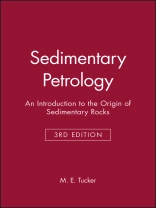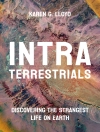The earlier editions of this book have been used by successive
generations of students for more than 20 years, and it is the
standard text on the subject in most British universities and many
others throughout the world.
The study of sediments and sedimentary rocks continues to be a
core topic in the Earth Sciences and this book aims to provide a
concise account of their composition, mineralogy, textures,
structures, diagenesis and depositional environments.
This latest edition is noteworthy for the inclusion of 16 plates
with 54 colour photomicrographs of sedimentary rocks in
thin-section. These bring sediments to life and show their beauty
and colorful appearance down the microscope; they will aid the
student enormously in laboratory petrographic work. The text has
been revised where necessary and the reference and further reading
lists brought up-to-date. New tables have been included to help
undergraduates with rock and thin-section description and
interpretation.
* New 16-page colour section will mean students do not need to
buy Longman Atlas
* All illustrations redrawn to higher standard
* Complete revision of text – new material on sedimentary
geochemistry, etc
Tabela de Conteúdo
Preface to the third edition vii
Preface to the second edition viii
Preface to the first edition ix
1 Introduction: basic concepts and methodology 1
1.1 Introduction 1
1.2 Basic concepts 1
1.3 Methodology 6
2 Siliciclastic sediments I: sandstones, conglomerates and breccias 11
2.1 Introduction 11
2.2 Sediment texture 11
2.3 Sedimentary structures 21
2.4 Palaeocurrent analysis 40
2.5 Detrital components of siliciclastic sediments 42
2.6 Classification of siliciclastic sediments 48
2.7 Petrography and origin of principal sandstone types 50
2.8 Sandstone composition, provenance and tectonic setting 53
2.9 Sandstone diagenesis 55
2.10 Porosity and permeability 62
2.11 Depositional environments of sandstones and coarser clastics 65
3 Siliciclastic sediments II: mudrocks 92
3.1 Introduction 92
3.2 Textures and structures of mudrocks 92
3.3 The colour of mudrocks 96
3.4 Mineral constituents of mudrocks 97
3.5 The formation and distribution of clay minerals in modern sediments 99
3.6 Diagenesis of clay minerals and mudrocks 102
3.7 Mudrocks and their depositional environments 103
4 Limestones 110
4.1 Introduction 110
4.2 Mineralogy of carbonate sediments 111
4.3 Components of limestones 111
4.4 Classification of limestones 128
4.5 Limestone grain size and texture 130
4.6 Sedimentary structures of limestones 130
4.7 Carbonate diagenesis 134
4.8 Dolomitization, dedolomitization and silicification 146
4.9 Porosity in carbonate sediments 151
4.10 Carbonate depositional environments and facies 151
5 Evaporites 166
5.1 Introduction 166
5.2 Gypsum and anhydrite 169
5.3 Halite 174
5.4 Other evaporite minerals and their occurrence 176
5.5 Evaporite dissolution and replacement 178
5.6 Evaporite sequences and discussion 178
6 Sedimentary iron deposits 182
6.1 Introduction 182
6.2 Source and transportation of iron 182
6.3 The formation of the principal iron minerals 183
6.4 Occurrence and petrography of the iron minerals 186
6.5 Precambrian iron-formations and Phanerozoic ironstones 189
6.6 Bog iron ores 192
6.7 Ferromanganese nodules and crusts, and metalliferous sediments 192
7 Sedimentary phosphate deposits 194
7.1 Introduction 194
7.2 Mineralogy 194
7.3 Nodular and bedded phosphorites 194
7.4 Bioclastic and pebble-bed phosphorites 197
7.5 Guano and ocean-island phosphorites 198
8 Coal, oil shale and petroleum 199
8.1 Introduction 199
8.2 Modern organic deposits 199
8.3 Ancient organic deposits 200
8.4 Coals and the coal series 200
8.5 Coal petrology 202
8.6 Coal formation and rank 204
8.7 Occurrence of coal 205
8.8 Oil shales 206
8.9 Formation of kerogen 207
8.10 Petroleum 207
9 Cherts and siliceous sediments 212
9.1 Introduction 212
9.2 Chert petrology 212
9.3 Bedded cherts 212
9.4 Nodular cherts 218
9.5 Non-marine siliceous sediments and cherts 219
10 Volcaniclastic sediments 221
10.1 Introduction 221
10.2 Autoclastic deposits 222
10.3 Pyroclastic-fall deposits 223
10.4 Pyroclastic-flow and -surge deposits 224
10.5 Hydroclastites: hyaloclastites and hyalotuffs 226
10.6 Epiclastic volcanogenic deposits 228
10.7 Diagenesis of volcaniclastic sediments 228
References 231
Index 251
Colour plates fall between p. 118 and p. 119
Sobre o autor
Maurice Edwin Tucker is a leading British sedimentologist, specialising in the field of carbonate sedimentology, more commonly known as limestones. From 1993 to 2011 he held the position of Professor of Geological Sciences at the University of Durham, and from 1998 to 2011 was Master of University College, Durham.












